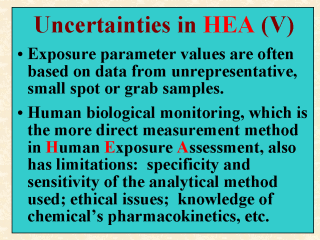| front |1 |2 |3 |4 |5 |6 |7 |8 |9 |10 |11 |12 |13 |14 |15 |16 |17 |18 |19 |20 |21 |22 |23 |24 |25 |26 |27 |review |
 |
Values used for
the exposure parameters typically are based on either policy defaults, professional
judgment, or, ideally, empirical data. It is important to note, however, that almost all
of these empirical data available to date were derived from small, unrepresentative spot
or grab samples. By spot sample, it means the sample size is less than adequate and, more
critically, the measurements are less than complete or representative. On the other hand,
grab samples are those in which the test subjects or observation units were not randomly
selected or assigned. These are actually opportunistic samples. Therefore, any assertion
that spot or grab samples would give a fair representation of the target population is an
intention at best. Even as complexly large as USDA's Nationwide Food Consumption Survey (as cited in Lecture 8) that covers all ages, genders, and regions, there is still a missing link between subpopulations living in regions with certain levels of food residues and their consumption rates. More bluntly, there appears to be a lack of correlation between exactly where the contaminant concentrates and exactly what the dietary patterns are for the people living in that area. Despite the fact that human biological monitoring (HBM) is considered to be a direct measurement method in human exposure assessment, it is not always a practical tool to use. The specificity and sensitivity of the analytical method used must be considered. So are the ethical issues. A knowledge of the chemical's pharmacokinetics is a prerequisite for HBM. The disadvantages and limitations of HBM were discussed extensively in Lecture 7. |